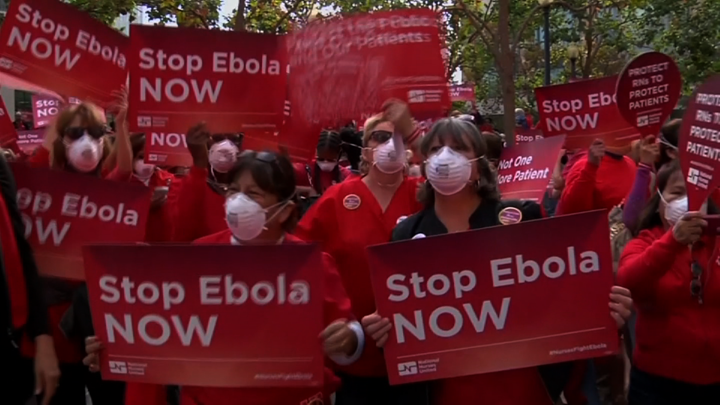Ebola has been called “the nurse killer” in West Africa. The disease has claimed more than 8,000 lives in what has become the largest outbreak since the disease was first discovered in 1976. But what is also unprecedented is the high proportion of “doctors, nurses, and other health-care workers who have been infected” according to the World Health Organization. As of Jan. 7, WHO reported 820 health-care workers have been infected and 488 have died.

Health organizations and authorities have said that Ebola is not an airborne disease and can only be spread through direct contact with bodily fluids of an infected person or animal.
But contagious disease expert Dr. Mark Nicas says it’s “biologically possible” for the Ebola virus to spread through small droplets.
READ MORE: Controversy surrounds respirator used for protection against asbestos
“If I can be hit in the face with one of those particles as a projectile, then it’s coming close enough to me that I can also inhale it.”
Nicas says when it comes to a disease as acute and deadly as Ebola it is best to follow the precautionary principal and ensure health-care workers are provided with the best possible protection.
What that best protection looks like is being debated across the continent. Many health agencies recommend health-care workers wear a disposable respirator classified as “N95” in high risk scenarios such as aerosol-generating procedures (AGMP). AGMPs include things like intubation and open respiratory/airway suctioning.

Get daily National news
Bonnie Castillo works with the biggest nurses’ union in the U.S. and is worried that the N95 leaks and allows fluids to get through.
“We know it leaks… We have experience in terms of having to constantly re-adjust. As you re-adjust you contaminate, and to contaminate with a deadly disease? You don’t gamble like that. You’re literally gambling with nurses lives.”
Dr. Nicas calls the policy “ridiculous” because it allows too much risk.
“It’s a fatal disease. If it’s in the air then you can inhale it. And if you can inhale it then you can become infected. That’s what I believe. You’re wearing a respirator an N95 filtering face piece. It’s not an adequate respirator to wear in an environment where you can be infected by inhalation transmission.”
WATCH BELOW: An extended interview with with Bonnie Castillo
Castillo and her union demanded recommendations in California change. Now nurses are provided with another respirator known as a powered, air-purifying respirator (PAPR) during AGMPs on confirmed Ebola patients. PAPRs can cover the entire face and use a powered fan to bring air in through a filter.
Across Canada, recommendations vary. Generally, the most protection required by health-care workers dealing with Ebola patients is an N95 respirator.
One mask manufacturer told 16×9 the N95 is only one piece of protection against Ebola and employers are responsible to ensure workers are fully protected. The Public Health Agency of Canada says PAPRs can actually be of further risk if staff is not properly trained on how to use them.
The World Health Organization agrees that risk comes “when infection control precautions are not strictly practiced.”These precautions often involve wearing layers of various equipment, training programs and strict protocol on putting on and taking off personal protective equipment.










Comments